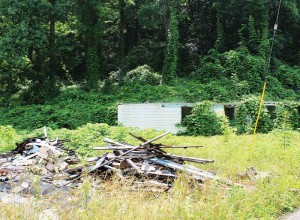Experts weigh-in on coal company’s record, role in 2011 Kayjay disaster
Editor’s note: This story was published in the Thursday, July 3, 2014, edition of The Mountain Advocate, a weekly newspaper published in Barbourville that covers Knox and surrounding counties. The story recounts the disastrous June 2011 flood that struck the community of Kayjay in southeastern Knox County. Bardstown-based Nally & Hamilton is being sued by a group of the flood’s survivors and estates of two victims, alleging the company’s mining practices contributed to the disaster.
By Melissa Newman, editor
The Mountain Advocate
BARBOURVILLE, Ky., July 3, 2014 — Scott Simonton, PhD, a professor at Marshall University who investigated erosional characteristics at the mine site of Nally & Hamilton’s operations in Kayjay, was questioned during a deposition at the Knox County Courthouse on Wednesday. His testimony indicated that Nally & Hamilton’s operations played a part in “worsening” flooding conditions through “run off.”

Property records from the Knott County PVA show some of the properties damaged in the June 2011 flood that devastated the Kayjay community in Knox County. Photo courtesy of The Mountain Advocate.
See related: Local mining company facing September trial for its role in E. Ky disaster
In October 2011, almost 80 flood victims filed the initial lawsuit alleging that Nally & Hamilton, a Bardstown, Ky. coal company with operations on the mountain looming above the Kayjay community, was “conducting mining activities in a dangerous and reckless nature … with disregard for the safety of others.”
Among violations issued, before the June 20, 2011 Kayjay flood, against Nally & Hamilton by Kentucky Energy and Environment Cabinet Department for Natural Resources Division of Mine Enforcement and Reclamation, two were not resolved at the time of the lawsuit was filed. Both violations involve the coal company being asked to remove debris blocking spillways and sediment structures.
Nally & Hamilton was given a violation for allowing material outside of the permit’s boundary to be deposited in a stream below three of the mine’s ponds during the rain event on June 20, 2011.
The plaintiffs are asking to be compensated for losses and also that Nally & Hamilton Enterprises be punished for their actions. The initial complaint summarizes the damages by stating, “During the tidal wave of debris unleashed by the Defendant, many of the Plaintiffs were left stranded in their homes and helplessly watched as their homes and personal possessions were destroyed and swept off and away.”
Wilma Pate and her deceased son, Donnie Pate’s case, is what Pillersdorf is calling a “representative family.” Pate’s case and story will be presented in a jury trial in September. The way the case is being presented is not a class action but rather a “representative” case with Pate and her son at the forefront. Pillersdorf said so many of the Kayjay cases are very similar – the stories, the damages – that Pate’s case will serve as a “manageable” way to present the facts and evidence to a jury.
The outcome of the Pate case will likely impact rulings for the others who are also listed as plaintiffs against Nally & Hamilton.

Kudzu covers parts of damaged homes and debris from the June 2011 flood that struck the Knox County community of Kayjay. A civil suit against Bardstown-based Nally & Hamilton alleges the company’s mining practices made the flooding worse. Photo courtesy of The Mountain Advocate.
In an unrelated but similar case in nearby Harlan County in March, The U.S. Environmental Protection Agency (EPA) reached an agreement with Nally and Hamilton Enterprises for filling streams at two coal mining sites in Kentucky in violation of the Clean Water Act (CWA). Under the terms of the Consent Decree, Nally will pay a total civil penalty of $660,000 and has agreed to restore three streams impacted during unauthorized coal mining activities.
Nally failed to obtain the necessary permit from the U.S. Army Corps of Engineers to place fill material into waters of the United States before it began work at the two coal mining sites. Nally’s operations are estimated to have adversely affected approximately 6,301 linear feet of waters, including 1,266 linear feet at the Fugitt Creek Site in Harlan County and 5,035 linear feet at the Doty Creek site in Knott County. The fill material Nally used remains in place today.
Under the Consent Decree, Nally will restore 7,611 linear feet of waters of the United States at the two mining locations. After restoration is complete, Nally will monitor the restored streams and submit annual monitoring reports to the EPA detailing the success of the restoration activities.
Attorneys for Nally & Hamilton Enterprises did not respond to calls for comment.
Melissa Newman is an author and award-winning journalist who calls Knox County home. She teaches journalism at Eastern Kentucky University and is a former editor of The Kentucky Standard. She is the author of “Growing Up Wilder,” “House of Cleaving” and “Sister Blackberry.”
-30-






